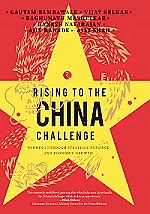
views
For many years, Indian policymakers were relatively complacent about the possibility of China developing technical and cultural prowess, given the extent to which one-party rule hinders free thinking and given the extent to which the intellectual capital of China was damaged during the Cultural Revolution (1966-1976). In those years, while China was disrupted by a populist frenzy and a rage against the elite, the great academic institutions of India such as the IITs, IISc, JNU, etc. had the opportunity to steadily gain strength. A policymaker in that period, feeling the reflected glory of the remarkable Indian intellectual achievements of S. Ramanujan, Rabindranath Tagore and C.V. Raman prior to Independence, suggested there was a thriving intellectual tradition even without state support, which could flower when there was a large increase in resourcing. India had a significant advantage through the use of English as the lingua franca, that fit naturally into the global use of English as the language of science, technology and business.
However, despite these initial advantages, the developments of recent decades have drastically changed the situation. China has now run ahead of India in intellectual capacity. China went from rank 35 (2013) to 14 (2019) in the Global Innovation Index, while in this period, India went from 66 to 52. That is, in 2019, India was not yet where China was in 2013. While a few top Indian universities have gained ground in the last 20 years, they are at ranks from 301 to 350 in the THES ranking. In contrast, China’s top university (Tsinghua) is at rank 23. Leaving aside the pure question of global ranking, the top Indian universities have a lopsided accent on STEM subjects, while China has fully built university capabilities in the social sciences and the humanities.
ALSO READ | What Changed Between 1996 and 2021 and Why China May Ignore Legitimacy Factor for Taliban
Whether we count the number of journal articles or patents, or we look at measures of quality such as the number of citations, China is now far ahead of India. While there is a stereotype of cheap Chinese goods, of China as a maker of low-end manufacturing, that stereotype is disconnected from the reality. China has successfully made the transition from low-skill production to high-skill production and achieved high scientific capabilities in the private sector through which R&D and innovation—and not just manufacturing—takes place.
The innovation system of any country does not rest on universities alone. When it works well, there is a rich ecosystem that shapes innovation, comprising government spending on space/nuclear/defence, government funding of research, public and private universities and other research organizations, private companies doing science and technology at the frontiers and a financial system that is able to supply risk capital. Each of these elements needs to have sound institutional foundations and all these elements need to deeply interact with each other. China has made important gains over India in each of these elements.
We need to, therefore, recognize the importance of innovation policy in the overall strategic picture of India’s China problem and undertake a series of actions through which India changes course, and gets back to the remarkable achievements of Indian science before Independence.
We must approach innovation policy from three points of view:
* How can the Indian state buy from innovative companies to a greater extent?
* How can the Indian state do better at addressing the needs of private firms in its in-house R&D and do better on transferring the fruits of this knowledge to private firms?
* How can the Indian state do better on spending money in ways that foster the development of intellectual capacity in the country?
The first problem (purchasing from innovative companies) links to the problems of the PFM of the life cycle of government contracting, from the tendering till the final payment or dispute resolution. The very tender conditions tend to often rule out younger/smaller firms. From the viewpoint of a firm, navigating government procurement is a dark art which requires significant investments in administrative capabilities on the side of private firms and more feasible for firms with political connections.
In order to address this, the PFM reforms are required through which government purchasing becomes more amenable to younger and smaller firms. Such work has begun in India in Pune, Maharashtra, and in Kerala. These models can be analysed, built upon and implemented across all arms of the Indian state.
The second problem involves reducing the barriers between government labs/universities and the private sector. All too often, in India, commercialization of intellectual capacity is seen as being akin to corruption. An array of rules need to change so that public labs/universities are respected and rewarded when they are sought out by private persons, when ideas make it out of the ivory tower into the real world, when researchers create companies and get directly involved in translating ideas into commercial success. There is a need to shift from the publish or perish mindset and its journal orientation to patent, prosper and publish, with a focus of becoming useful in the real world.
The third problem involves a fundamental change in perspective about public spending in space, defence, nuclear, health and science, where the objective shifts from hiring researchers inside government organizations to funding research that takes place in external universities (private or public) and private firms.
ALSO READ | Critical of Nehru’s China Policy, Savarkar Wanted India to Emulate Israel
When there is government spending on R&D, there is a global public goods character (a paper appears on a website and everyone in the world benefits). As Indian GDP is increasingly important on a global scale, we should think about doing our fair share of global knowledge production. In addition, there are positive externalities that are imposed within the country. The classic story is that of the US where, starting from World War II and then in the Cold War, government programmes in defence–nuclear–space generated an impact upon the knowledge of individuals and firms in the US, which laid the foundations of the US’s technological and economic domination worldwide. There are large positive externalities when knowledge is produced in the country, when intellectual capacity is created in the country, which justify state financing.
The interesting public policy puzzle involves precisely how state financing is turned into the highest gains for the economy. In the traditional Indian arrangements, organizations like Broadcast Audience Research Council, Defence Research and Development Organisation or Indian Space Research Organisation (ISRO) operate in silos, and there is remarkable production of knowledge and capability, but the positive externalities imposed upon the economy are low. For a counter-example, consider NASA. The NASA has a small core of employees and, for the rest, contracts out everything to universities (public and private) and private firms. As a consequence, all the public expenditure in NASA has a large impact upon the knowledge of individuals in the country. Organizations like ISRO need to change gears to shift to this way of working, where ISRO would become a team which is engaged in high-level design and has expertise in government contracting.

Read all the Latest News , Breaking News and Ukraine-Russia War Live Updates here.



















Comments
0 comment